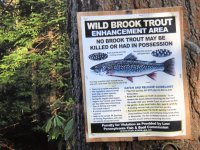silverfox
Well-known member
- Joined
- Oct 4, 2006
- Messages
- 1,928
Maybe because those recovered waters don't have nonnative fish species present?I find it very interesting that all of the proposed C&R streams were previously dead or declining from acid rain. Declines caused by man, and then reversed by man through limestone sand dosing, which requires maintenance. But no C&R for the streams that are natural brook trout factories with clean water.





